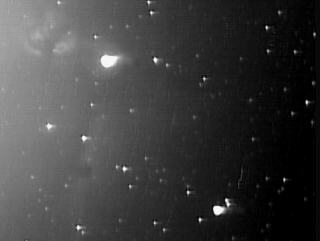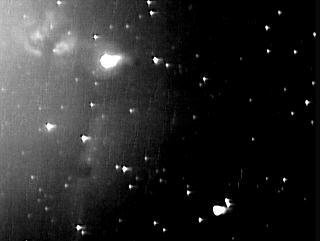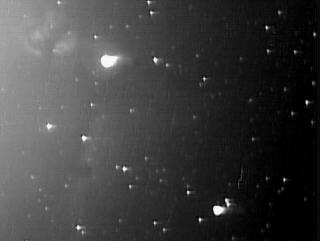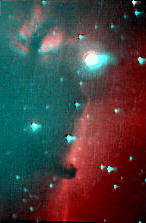K3PGP.Experimenter's.Corner
![]()
K3PGP.Experimenter's.Corner
![]()
Home Astronomy Bicycle Construction Laser Moonbounce Software Guest Misc Sales
The
horsehead from my light polluted front yard!
12-02-04
Adjust
brightness and Contrast
 |
 |
 |
Ok, don't laugh. These are probably the worst astrophotos of IC434 and B33, The Horsehead that you've ever seen. What you may not realize is that the above photos were taken pretty much in real time from my light polluted front yard where most of the time about the dimmest star I can see naked eye is magnitude 2. The moon was in the sky and B33 was rising in the east and just clearing the treetops neither of which was helping. I have taken a look at this part of the sky many times both through the eyepiece and with the CCD camera with scopes up to 10 inches in diameter and was never able to see anything other than the brighter stars in the area. So how did I finally have success? And with a scope of less than 4 inch aperture?
If you guessed that filters were involved you would be right! I've tried a number of different light pollution filters with no success. Yes they got rid of SOME of my light pollution but what I was left with was unusuable as I wasn't able to see anything that I could not see without the filters. That is until I tried a 650 nm interference filter that I've had in my optics junk box left over from some free space laser communication experiments. This particular filter is 80 nm wide.
Now that I know that this works I have several other filters in the 630 to 690 nm region with bandwidths ranging from 0.3 to 100 nm which I want to compare. I'm also starting to think that with proper selection of some narrow band filters in the green and blue region of the optical spectrum I just may be able to do some color astrophotography right from my light polluted front yard.
Unfortunately the clouds rolled in right after my first successful images of the Horsehead so I was unable to experiment. <Weather> I was hoping to capture this object later in the evening when it was higher in the sky as the photos above were taken as it was rising in the east. By the way I was able to detect B33 in REAL TIME on the video monitor when running the Mintron camera at 128x integration and the above photos pretty much duplicate what I saw on the LCD monitor. I was unable to take long integration exposures as I shot these photos through holes in the rapidly moving cloud cover. I feel quite certain that when this object is higher in the sky on a clear night when I am able to lock on to it for a longer period of time that I will be able to improve the signal to noise ratio. The photos are a bit brighter on the left hand side due to amp glow as no dark frames were subtracted and no processing was used. These are real time snapshots of the output of the Mintron video camera running at 128x integration.
The widefield scope was used to take the above photos along with the GMV-EX6K / MINTRON 12V1E-EX CAMERA and a motorized 15 to 180 mm Burle lens set at 180 mm. This lens is very similar to the Fujinon 16-160 mm zoom lens but has just a bit more range on both ends of the zoom.
!!! UPDATE !!!
 |
First attempt at color using three filters for red, green, and blue between the same lens (less than 4 inch aperture) and the GMV-EX6K / MINTRON 12V1E-EX which is monochrome (black and white) camera. This was extremely
time consuming as I presently |
This photo was taken a few weeks later on a moonless night when B33 was a bit higher in the sky. As you can see there are alignment and focus issues especially with the red frame. Some of this could be fixed by editing the photo. The photo above is pretty much what came out of the camera! As noted elsewhere the lens I am using does NOT focus the deep red part of the spectrum the same as the rest of the spectrum which is why I normally use it with an infrared blocking filter. This is a shame as most CCD cameras have an extended red response (see graph) and to throw this part of the spectrum away is a bit of a waste. I can take images in this part of the spectrum with no difficulty as long as a suitable passband filter is used as the lens I am using does NOT focus the deep red to the same focal point as the blue and green part of the spectrum. In other words, I can take images in the red part of the spectrum but NOT at the same time as blue and green! And I have to refocus when imaging in the red. How much refocusing is needed depends on how far into the red / infrared I am pushing the system and how poorly corrected the system is at those wavelengths.
This is a common problem with many (dare I say almost all?) refractors and especially most zoom lens. Most are fairly well corrected at 656 nm, the hydrogen emission wavelength but you may be in for a surprise if the filter you are using allows light to pass beyond that wavelength! Reflectors do not have this issue. It is not an issue when using any system with an IR blocking filter for monochrome imaging (as long as one can afford to throw away this part of the spectrum!) and with a bit of work I'm sure the issues concerning the red frame can be worked out. Remember this was my FIRST attempt at imaging an object in color that I can not even see with my eyes through any of my scopes due to light pollution. I don't plan on doing much in the way of color work until I come up with a way to make a suitable color wheel as taking the system apart four times for each photo is a bit much as this system does not come apart like a typical telescope. There is no eyepiece and everything screws together.
Home Astronomy Construction Laser Moonbounce Software Guest Misc
Contents of this website are ©1995-2012 of K3PGP and of the originating authors.